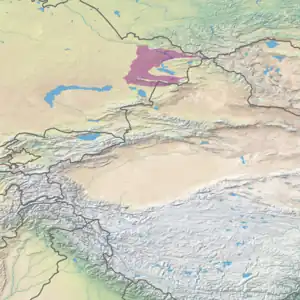| Altai steppe and semi-desert | |
|---|---|
 Akzhar, District Of Tarbagatay - Gates Of Village | |
 Ecoregion territory (in purple) | |
| Ecology | |
| Realm | Palearctic |
| Biome | Temperate grasslands, savannas, and shrublands |
| Geography | |
| Area | 82,880 km2 (32,000 sq mi) |
| Countries | |
| Coordinates | 48°50′N 82°0′E / 48.833°N 82.000°E |
The Altai steppe and semi-desert ecoregion (WWF ID: PA0802), as its name indicates, sits in a transition zine between steppe and semi-desert, supporting sparse grass and shrublands. The area is relatively undeveloped, with agriculture mostly represented by grazing livestock. There are a few shallow lakes in depressions used by migratory birds.[1][2][3]
Location and description
The ecoregion is situated between steppe on its south (the Emin Valley steppe ecoregion) and conifer forests to its north (the Altai montane forest and forest steppe ecoregion). To the west is the Kazakh semi-desert ecoregion and to the east is the Junggar Basin semi-desert and Lake Zaysan. The Irtysh River runs along the northeast of the ecoregion, and the Tarbagatay Mountains along the south.[2] A small portion of the ecoregion reaches into China.
Climate
The climate of the ecoregion is Humid continental climate, warm summer (Köppen climate classification (Dfb)). This climate is characterized by large seasonal temperature differentials and a warm summer (at least four months averaging over 10 °C (50 °F), but no month averaging over 22 °C (72 °F).[4][5]
Flora and fauna
The ground cover is grassland, shrubs, and bare rock. Use of the land for livestock range is putting pressure on wildlife. The Manrak ridge in the southeast of the region is an important area for birds, with 121 species identified.[6]
See also
References
- ↑ "Altai steppe and semi-desert". World Wildlife Federation. Retrieved March 21, 2020.
- 1 2 "Map of Ecoregions 2017". Resolve, using WWF data. Retrieved September 14, 2019.
- ↑ "Altai steppe and semi-desert". European Commission, Joint Research Centre, Digital Observatory for Protected Areas. Retrieved March 23, 2020.
- ↑ Kottek, M., J. Grieser, C. Beck, B. Rudolf, and F. Rubel, 2006. "World Map of Koppen-Geiger Climate Classification Updated" (PDF). Gebrüder Borntraeger 2006. Retrieved September 14, 2019.
{{cite web}}: CS1 maint: multiple names: authors list (link) CS1 maint: numeric names: authors list (link) - ↑ "Dataset - Koppen climate classifications". World Bank. Retrieved September 14, 2019.
- ↑ "Manyrak Mountains". Birdlife International. Retrieved March 23, 2020.